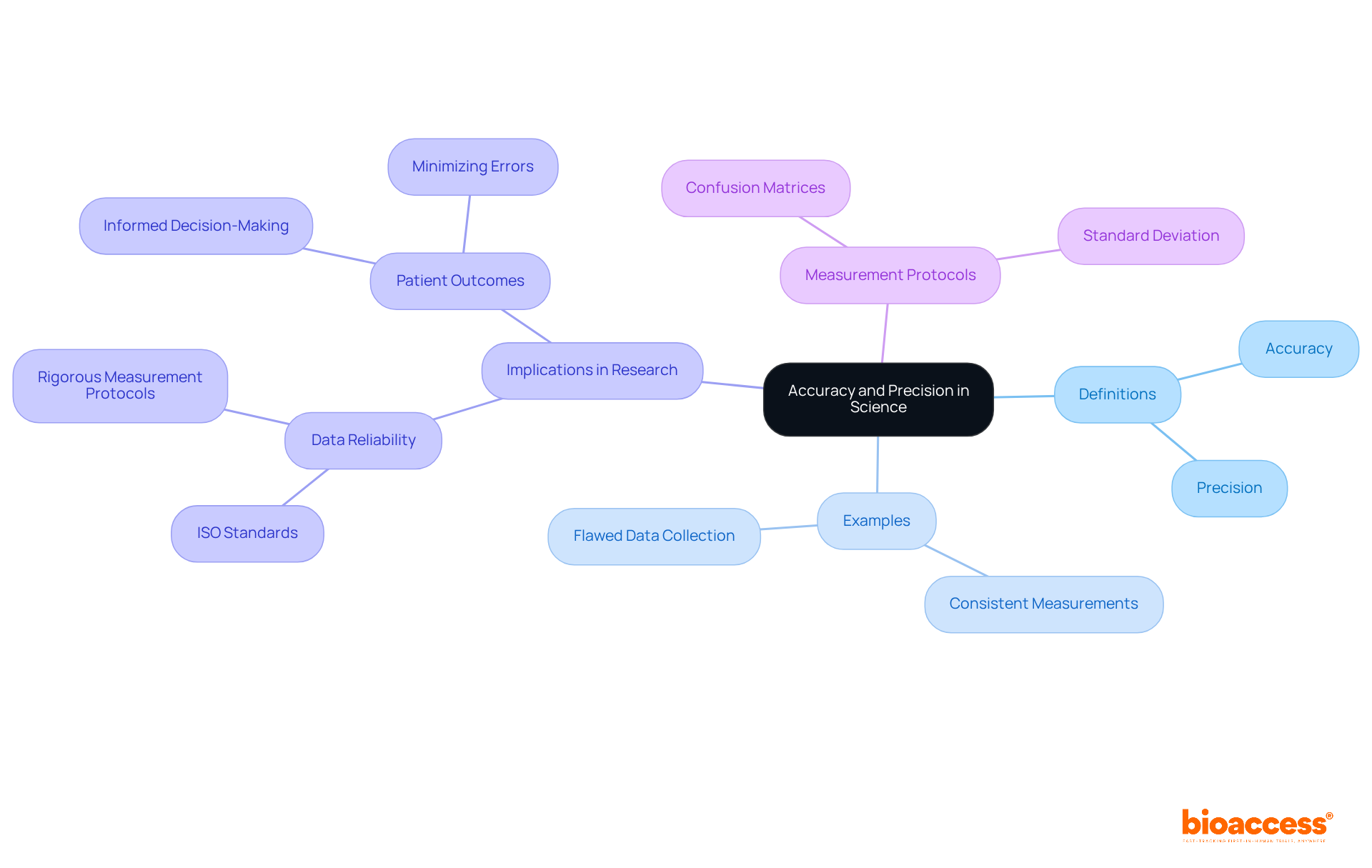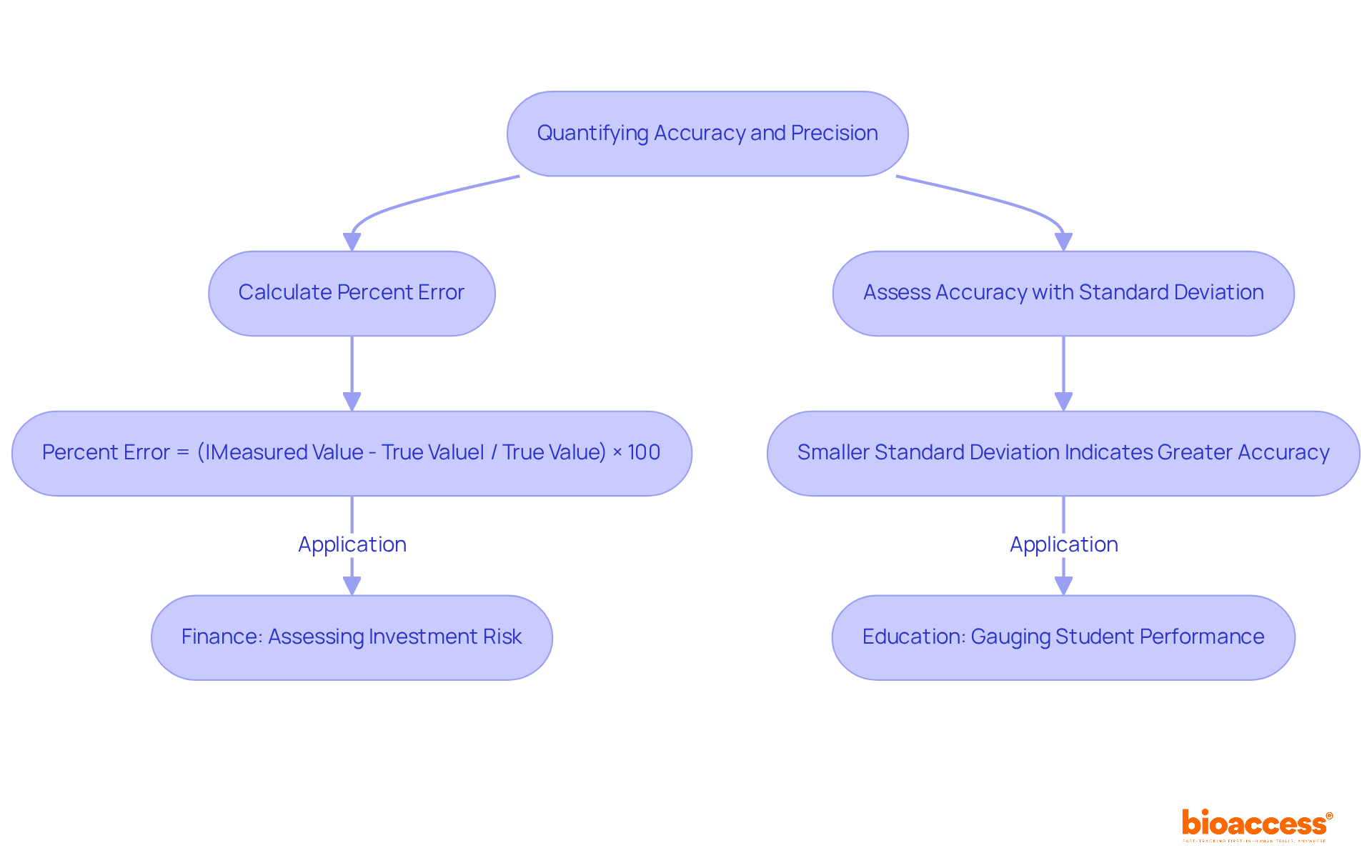


Precision in scientific research stands as a cornerstone for reliable data interpretation and valid conclusions. As researchers navigate the complexities of accuracy and precision, grasping these concepts is essential for enhancing study design and minimizing errors. Alarmingly, up to 30% of medical studies suffer from flawed data collection, raising a critical question: how can researchers ensure their methodologies align with established standards and genuinely reflect scientific truths?
This guide explores the definitions, calculations, and applications of precision in science, equipping researchers with the necessary tools to elevate their work and improve outcomes.
Accuracy refers to how close a measurement is to the actual or accepted value, while consistency relates to the reliability of repeated measurements. For example, if a scale consistently shows a weight of 5 kg for an object that truly weighs 5 kg, it is both accurate and precise. Conversely, if the scale displays weights of 4.9 kg, 5.1 kg, and 5.0 kg for the same object, it demonstrates precision without accuracy. This distinction is vital for researchers who need to define precise in science, as it directly influences data interpretation and the validity of conclusions drawn from studies.
In clinical research, methodologies that define precise in science enhance the reliability of results, while accurate data ensures that findings reflect true outcomes. Alarmingly, up to 30% of medical studies encounter issues related to flawed data collection, highlighting the need for rigorous measurement protocols. Adhering to ISO standards can guarantee dependable outcomes in terms of correctness and exactness. By grasping these concepts, researchers can design robust studies, minimize errors, and ultimately improve patient outcomes through informed decision-making.
As noted by Any.do, "Accuracy concerns how near results are to the actual value, while consistency pertains to the reliability of obtaining similar outcomes." Additionally, tools like confusion matrices can help identify classification strengths and weaknesses, further underscoring the importance of these concepts in clinical settings. How can your research benefit from a deeper understanding of accuracy and consistency?

The International Organization for Standardization (ISO) defines accuracy as a combination of trueness and exactness. Trueness signifies how closely the average of a collection of readings corresponds with the actual value, while consistency represents the reliability of repeated readings under stable conditions. For instance, ISO 5725 offers comprehensive definitions and highlights the essential role both elements play in achieving dependable results. A system can be accurate, and to define precise in science, it can be both or neither, illustrating the nuanced relationship between these concepts.
Understanding these standards is vital for researchers, as they help to define precise in science methodologies that align with global benchmarks for correctness and exactness. Adhering to ISO standards not only enhances the credibility of research findings but also fosters reproducibility and reliability in scientific investigations. Recent ISO standards continue to evolve, providing revised guidelines that incorporate advancements in measurement techniques and methodologies, thus emphasizing the significance of correctness and exactness in research practices.
According to the ISO, "Accuracy shows how close your results are to the actual value, while consistency indicates how reliably you can attain the same outcomes." Furthermore, systematic error evaluation and routine calibration of instruments are essential for maintaining correctness and exactness in research.

To quantify accuracy, researchers calculate percent error by comparing the measured value to the true value using the formula:
Percent Error = (|Measured Value - True Value| / True Value) × 100.
In assessing accuracy, the standard deviation of repeated observations is computed. A smaller standard deviation indicates greater accuracy. For instance, if a researcher evaluates the same sample multiple times and obtains values of 10.1, 10.0, and 10.2, the resulting low standard deviation signifies high accuracy in these assessments.
These calculations are crucial for researchers aiming to define precise in science methodologies and enhance the reliability of their results. Understanding the average standard deviation in research studies across various fields helps to define precise in science and underscores its importance in evaluating accuracy. For example, in finance, standard deviation is instrumental in assessing investment risk, while in education, it gauges the consistency of student performance. Recent advancements in measurement methods, particularly those from the MIT Quantum Initiative, have significantly improved reliability and precision, which serve to define precise in science and enable more dependable data interpretation. Real-world examples, such as the effective immune response observed in studies utilizing nanoparticles for vaccine delivery, illustrate the practical application of percent error and standard deviation calculations in research. By employing these precision calculations, researchers can define precise in science to ensure that their findings are robust and trustworthy.

In classification tasks, accuracy is defined as the ratio of valid results—both positive and negative—among the total number of cases examined. Precision, on the other hand, measures the proportion of true positives among all positive predictions made by the model. For instance, consider a medical diagnostic test where a model predicts 100 positive cases, and 80 of those are truly positive; the accuracy is calculated as 80%. This metric is crucial in medical diagnostics, as high accuracy minimizes the risk of false positives, which can lead to unnecessary treatments or anxiety for patients. In a spam detection scenario, a model identified 3 spam emails out of a total of 6 predicted as spam, resulting in an accuracy of 50%.
Recent advancements in classification metrics have introduced sophisticated tools that enhance traditional measures. The F1 Score, for example, combines accuracy and recall into a single metric, providing a balanced view of model performance, especially in scenarios with unequal classes. Conor Bronsdon emphasizes that selecting appropriate precision metrics transforms raw outputs into meaningful insights, enabling researchers to fine-tune performance to meet specific objectives. In clinical settings, maintaining high accuracy is paramount; a study in cancer detection underscored that maximizing recall is essential to identify as many actual positive cases as possible, even if it leads to an increase in false positives.
Current benchmarks for accuracy and precision in classification models are evolving, with platforms like Galileo offering autonomous evaluations tailored to specific model requirements. These innovations empower researchers to assess model reliability more effectively, ensuring that diagnostic tools are both accurate and trustworthy. Understanding these metrics equips researchers to make informed decisions regarding their applications in clinical environments, ultimately enhancing patient care.

Understanding precision in scientific research is crucial for producing reliable and valid results. It’s essential to distinguish between accuracy and precision, as these concepts significantly influence data interpretation and the integrity of scientific conclusions. Researchers who grasp these definitions and apply them rigorously can enhance the credibility of their work, contributing to more informed decision-making in their fields.
Key insights reveal that:
The discussion of ISO standards underscores the significance of adhering to established benchmarks to ensure correctness and exactness in research methodologies. By quantifying accuracy through metrics like percent error and standard deviation, researchers can assess their findings more effectively, fostering reproducibility.
Ultimately, a deeper understanding of accuracy and precision benefits not only individual research efforts but also enhances the broader scientific community's ability to advance knowledge and improve outcomes. Researchers are encouraged to adopt rigorous measurement practices and leverage modern tools and metrics to refine their approaches. By doing so, they can ensure that their findings are not only precise but also impactful, paving the way for advancements that benefit society as a whole.
What is the difference between accuracy and precision in scientific terms?
Accuracy refers to how close a measurement is to the actual or accepted value, while precision relates to the reliability of repeated measurements.
Can you provide an example of accuracy and precision?
If a scale consistently shows a weight of 5 kg for an object that truly weighs 5 kg, it is both accurate and precise. However, if the scale displays weights of 4.9 kg, 5.1 kg, and 5.0 kg for the same object, it demonstrates precision without accuracy.
Why is the distinction between accuracy and precision important for researchers?
This distinction is vital for researchers because it influences data interpretation and the validity of conclusions drawn from studies.
How do accuracy and precision relate to clinical research?
In clinical research, methodologies that define precision enhance the reliability of results, while accurate data ensures that findings reflect true outcomes.
What percentage of medical studies face issues with data collection?
Up to 30% of medical studies encounter issues related to flawed data collection.
How can researchers ensure dependable outcomes?
Researchers can ensure dependable outcomes by adhering to ISO standards, which guarantee correctness and exactness in measurements.
What tools can help identify classification strengths and weaknesses in clinical settings?
Tools like confusion matrices can help identify classification strengths and weaknesses, emphasizing the importance of accuracy and precision in clinical settings.
How can a deeper understanding of accuracy and consistency benefit research?
A deeper understanding of these concepts can help researchers design robust studies, minimize errors, and improve patient outcomes through informed decision-making.